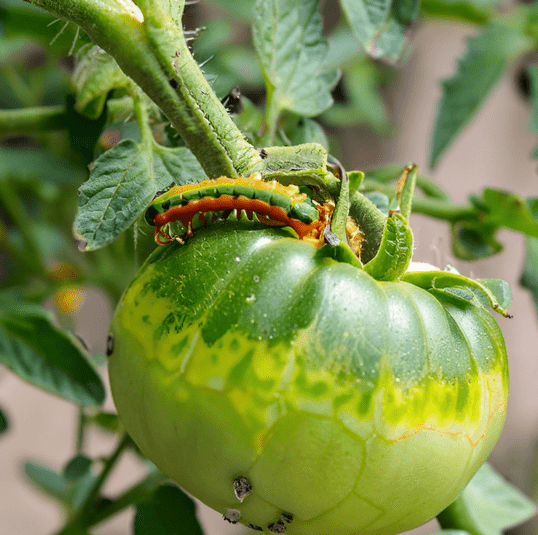Step into the realm of tomato care with insights on common challenges and easy fixes. Explore “Tomato Plant Diseases and Solutions” to safeguard your precious plants. Learn the ropes of maintaining a healthy tomato patch as we unravel the mysteries of potential issues and their remedies. Ready to nurture your tomatoes? Let’s navigate the world of plant health together!.
1. Early Blight
Symptoms:
Circular, dark spots on lower leaves, which spread and cause leaf yellowing and withering.
Deeper Dive:
Early Blight, caused by the sneaky fungus Alternaria solani, loves warm and humid spots. Picture it spreading like a puzzle across leaves.
Solution:
Remove affected leaves promptly, apply a copper-based fungicide, and practice crop rotation.
Pro Tips:
Besides the basics, consider providing your tomatoes with a bit more space for a breath of fresh air, preventing the fungus from spreading.
2. Late Blight
Symptoms:
Water-soaked lesions on leaves, which can spread quickly, affecting stems and fruit.
Deeper Dive:
Late Blight, the weather-wielding nemesis Phytophthora infestans, thrives in cool and wet conditions. Imagine it as a mischievous rain dance on your tomatoes.
Solution:
Remove and destroy affected plant parts, use copper-based fungicides, and avoid overhead watering.
Pro Tips:
Choose tomato varieties with resistance and become a weather forecaster, applying fungicides preventively during risky weather spells.
3. Tomato Hornworm
Symptoms:
Large green caterpillars feeding on tomato leaves.
Deeper Dive:
Tomato Hornworms are like leafy dragons, blending in with the leaves. Picture a garden patrol to spot them during their active dusk and dawn hours.
Solution:
Handpick hornworms, use biological controls like parasitic wasps, or apply insecticidal soap.
Pro Tips:
Besides the usual, plant some marigolds to act as vigilant knights guarding your tomatoes.
4. Blossom End Rot
Symptoms:
Dark, sunken spots on the bottom of tomatoes.
Deeper Dive:
Blossom End Rot is a calcium snack deficiency! Envision your tomatoes enjoying a steady watering routine and munching on calcium-rich treats.
Solution:
Ensure consistent watering, maintain proper calcium levels in the soil, and use mulch to regulate soil moisture.
Pro Tips:
In addition to mulch, ensure your tomatoes have a rich diet with a balanced fertilizer to avoid nutrient shortages.
5. Aphids
Symptoms:
Small, soft-bodied insects gathering under leaves.
Deeper Dive:
Aphids are like tiny leaf-sipping vampires. Imagine a water brigade washing them away or ladybugs having a feast at an aphid banquet.
Solution:
Use a strong stream of water to dislodge aphids, apply insecticidal soap, or introduce natural predators like ladybugs.
Pro Tips:
Consider planting aromatic herbs like basil to create a natural shield against aphids.
6. Septoria Leaf Spot
Symptoms:
Small, circular spots with gray centers and dark edges on leaves.
Deeper Dive:
Septoria Leaf Spot, caused by the stealthy fungus Septoria lycopersici, loves hiding in old plant bits during winter. Picture it as a sneaky intruder.
Solution:
Remove infected leaves, apply copper-based fungicides, and avoid overhead watering.
Pro Tips:
Aside from the standard care, keep your garden tidy by removing debris, and perhaps consider a strategic positioning to minimize humidity.
7. Fusarium Wilt:
Symptoms:
Yellowing of lower leaves, wilting, and stunted growth.
Deeper Dive:
Fusarium Wilt, caused by the fungus Fusarium oxysporum, blocks water uptake in tomato plants. Imagine it as a clogged water pipe.
Solution:
Plant resistant varieties, practice crop rotation, and maintain soil health.
Pro Tips:
Avoid planting tomatoes in soil previously affected by Fusarium Wilt.
8. Verticillium Wilt:
Symptoms:
Yellowing and wilting of lower leaves, followed by branch dieback.
Deeper Dive:
Verticillium Wilt, caused by Verticillium dahliae, attacks the vascular system of tomato plants. Visualize it as a roadblock in the plant’s water transportation system.
Solution:
Choose resistant tomato varieties, practice crop rotation, and ensure proper soil drainage.
Pro Tips:
Mulching and maintaining consistent soil moisture can help reduce the risk of infection.
9. Gray Mold (Botrytis cinerea):
Symptoms:
Grayish, fuzzy mold on leaves, stems, and fruit.
Deeper Dive:
Gray Mold, a fungus, thrives in cool, humid conditions. Think of it as a silent intruder slowly enveloping your tomatoes.
Solution:
Remove infected plant parts, improve air circulation, and avoid overhead watering.
Pro Tips:
Prune your tomatoes for better airflow and consider growing them in well-ventilated areas.
10. Mosaic Virus:
Symptoms:
Mottled, yellow-green leaves with distorted growth.
Deeper Dive:
Mosaic Virus can be transmitted by aphids and affects tomato plants’ overall health. Imagine it as a mysterious ailment.
Solution:
Remove infected plants to prevent the virus from spreading. Control aphids with insecticidal soap.
Pro Tips:
Ensure good weed control in your garden, as some weeds can host the virus.
These additional tomato diseases can pose challenges to your tomato garden. Vigilance, good gardening practices, and prompt action are essential in managing and preventing their spread.
Conclusion
By following these planting and care tips and being vigilant against common tomato plant diseases, you can promote healthy growth and maximize your tomato harvest. Remember that prevention and early intervention are key to successful tomato gardening.



